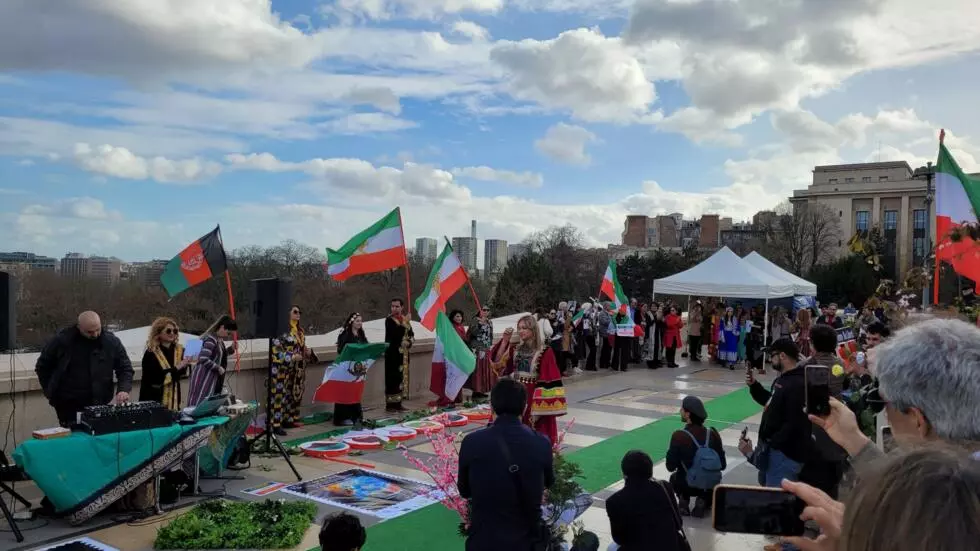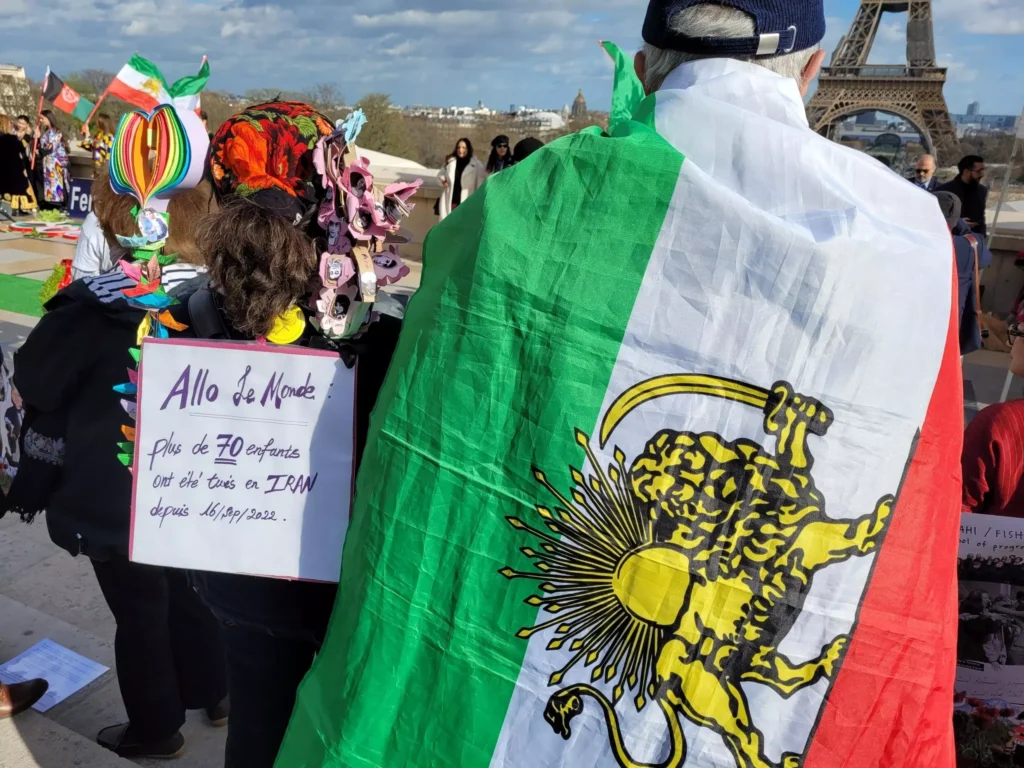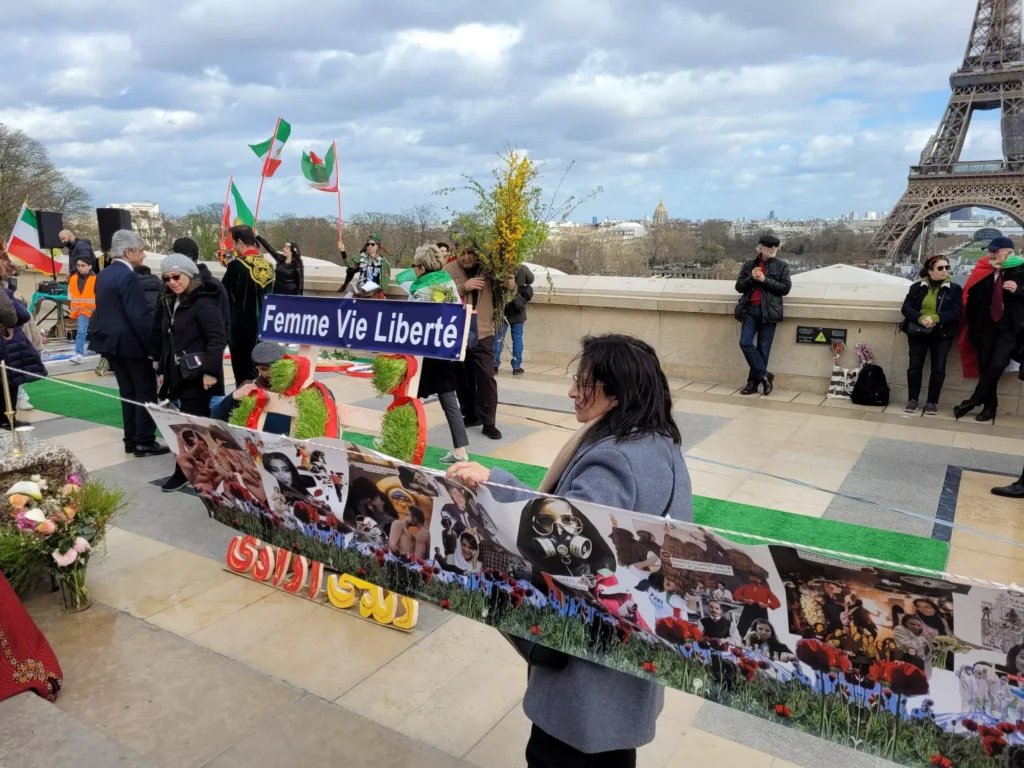Palais de Chaillot, March 25, 2023: The Hamava association, in partnership with around twenty other associations and collectives (Rudaki, International Norouz Day, Femme Azadi, Institut Regard Persan, Aftab, We Are Iranian Students, Maison Tahissa, the Montpellier Woman-Life-Freedom Collective, The Dissident Club, and Afghan, Indian, Tajik, Pakistani, and Zoroastrian associations, among others), is organizing this year’s #Norouz Festival on March 25, 2023, from 4 p.m. to 8 p.m., in support of the “Woman, Life, Freedom” movement.
The event takes place on the support terrace of the Palais de Chaillot in the Trocadéro Gardens.
An ancient celebration for 300 million people — a living cultural heritage. Let’s share this festival with the citizens of the world.
When Human Rights Take Part in the Norouz Festivities in Paris
Published on: March 26, 2023 – 5:11 p.m.

On the Esplanade of Human Rights, a location symbolic in more ways than one, at Place du Trocadéro in Paris, the wind swirls Afghan and Iranian flags during the Norouz festivities on March 25, 2023. © Anne Bernas / RFI
Text by: Anne Bernas
Tradition obliges, the millennia-old Persian spring festival is, as every year, celebrated by more than 300 million people around the world. But this year, the atmosphere is more politically charged than festive, aiming to defend the rights of Iranian and Afghan women.
“We are here today to celebrate, but also to show our solidarity with oppressed peoples, because this year the celebration carries a tone of sadness,” says Maryam, a French-Iranian woman in her fifties, holding a basket full of flowers whose petals scatter in the wind.
On the Esplanade of Human Rights, a location symbolic in more ways than one, at Place du Trocadéro in Paris, the wind swirls Afghan and Iranian flags. Gusts sweep through, making the dresses and costumes from Persian, Afghan, Uzbek, Tajik, Indian, Turkish, Kazakh, and other cultures dance to the sounds of traditional music.
A Double Rebirth
A long table displays the symbols of Norouz, the festival celebrating the rebirth of spring. The cultural heritage of Norouz was inscribed in 2009 on UNESCO’s and the UN’s Intangible Cultural Heritage of Humanity list as an international festival born from a millennia-old cultural legacy. And in 2023, the word “rebirth” takes on several meanings. The Haft Sîn (the Seven S’s) includes seven elements whose names begin with the letter “S” and each carries its own symbolic value, representing a form of renewal.
Right next to it this year stands another booth: signs taped to the ground explain the situation of women’s rights in several countries that celebrate Norouz. On a small table sits the portrait of Mahsa Amini, the young woman who became tragically famous on the day of her death and is now a symbol of the repression of protests in Iran.
On the occasion of Norouz, Iranian women and men gather to celebrate the New Year around the sacred flames. This symbol has been adopted by the “Woman, Life, Freedom” movement as a sign of protest against the death of Mahsa Amini. Iranian women have transformed this symbolic tradition into a political act, burning their veils in the fire and dancing around it. This is why this year, Norouz takes on an even more symbolic meaning and is celebrated in tribute to Iranian women who long for freedom.

Signs taped to the ground explain the situation of women’s rights in several countries that celebrate Norouz, on the Esplanade of Human Rights in Paris, March 25, 2023. © Anne Bernas / RFI
“This year, we dedicate this gathering to the ‘Woman, Life, Freedom’ movement, to all the women of Iran and Afghanistan who fight every day against a tyrannical, dictatorial, theocratic, and above all misogynistic government,” explains Nazila Golestan, spokesperson for the Hamava association (National Coalition for a Free and Democratic Iran), wearing a long traditional Persian coat embroidered with golden threads.
“Yes, it’s very politicized today, whereas usually it isn’t at all,” analyzes the son of the president of the Committee for the Support of Human Rights in Iran and a political refugee, wearing a sumptuous velvet and embroidered coat and celebrating Norouz for twenty-seven years. “In 2023, I’m an infiltrator in a Tajik costume,” jokes the young man, admitting that he hasn’t really celebrated this year.
A Call for Peace
Wrapped in a gigantic Iranian flag, Arsalan, 63, says: “I participate in the festivities every year, but this year they have a special significance with ‘Woman, Life, Freedom.’ Women have always held an essential place in Persian culture. We no longer want Islam; we want to return to our origins.” The French-Iranian adds that he has now entered into an identity and cultural struggle. “We are in the midst of a revolution today, a rebirth in people’s minds, and I want to believe in it! It’s a long-term struggle,” he insists as the music grows louder and his wife begins a few dance steps while singing at the top of her lungs.
For Pierre Hossein Lotfalizadeh, an organizing member of the festivities and president of the Institut Regard Persan, the brutal repression in Iran over the past six months has, however, managed to unite the Iranian diaspora more than ever, especially during the Norouz celebrations. “We can see it this year: there are many more people than usual, Iranians but also spectators who don’t usually attend.” Pierre Hossein Lotfalizadeh makes a wish: that Norouz 2024 will be celebrated in a democratic Iran, “that this regime which has occupied Iran for 44 years disappears, and that peace spreads beyond Iran.”

This year for Norouz, the atmosphere is more about political protest than celebration. © Anne Bernas / RFI
“We are outside, but this allows us to be freer in conveying the message of those inside,” proclaims Massoud Mirshahi, head of International Norouz Day. “But France, regarding Iran, is very conservative. You can feel that it doesn’t know which path to choose, but it cannot remain in this position. Iranians have their eyes on France, known for its freedoms. The messages coming from here therefore carry fundamental value.”
To achieve this, the path seems long given how fierce the repression is. And some, like Arash, 70, question the movement, which he considers “Islamo-leftist and taking over France.” “France gave me everything; it taught me human rights, women’s rights. But the feminist organizations that usually rise up for everything related to women’s rights violations — where are they to denounce what’s happening in Afghanistan or Iran? These are the darkest regimes in humanity… ‘Woman, Life, Freedom,’ it’s the most beautiful slogan in the world! Where are the feminists to defend it? Don’t they see what’s happening in Iran?” he exclaims, tears in his eyes.
At the same time, Alexandra Szpiner, a French elected official, proclaims to applause from the audience: “The mullahs, this totalitarian regime, this regime of darkness, is your enemy, it is our common enemy. Every day we must be here to express our horror and our anger. France must stand, with Europe, to declare that the Revolutionary Guards, this armed arm of terror, must be placed on the list of terrorist organizations.”
With @fridaker, we attended at the Trocadéro the magnificent celebration of Norouz, the Persian New Year, in support of the Woman, Life, Freedom movement and these Iranian women who, despite the terror of the mullahs, give us a lesson in courage and dignity. pic.twitter.com/ivvjPydXdY
— Alexandra Szpiner (@ScarlettSzpiner) March 26, 2023
Yet, on the Esplanade of Human Rights, hope prevails and the resolve seems unbreakable. “It’s like a game of chess,” says Massoud Mirshahi. “You have to move the pawns carefully so you can attack. But for that, you must be organized. If at least we can get women in Iran to remove the hijab, that will already be a first step to break the Islamic authorities. We are counting on the youth for that…”
#Norouz Iranian New Year, under the banner of #FemmeVieLiberte and #IranRevolution at the Trocadéro in #Paris. May this new year finally see the end of the mullahs’ regime in #Iranian! ♀ pic.twitter.com/Ts53YjMq8W
— Arlette_Zilberg (@Arlette_Zilberg) March 25, 2023
The Youth Mobilized
And the youth answered the call, filling the Esplanade of the Trocadéro. This year, Norouz is also an opportunity to highlight various initiatives aimed at making the world aware of human rights violations. “I,” says a young French-Iranian student, “am here to talk about We Are Iranian Students, an association I am part of. Our goal is to amplify the voices of students who are being persecuted today,” following the example of political prisoner sponsorships, which have seen some success in raising awareness.
Her group has thus created a database that records the precise status of arrested students — name, surname, photo, field of study — all information provided by local student unions via the Telegram app. “Today, we have collected 800 names, but we know the real numbers are much higher. We also know that 400 of them have been sentenced or are still in prison.” To ensure these young people are not forgotten, We Are Iranian Students is working to establish an international academic sponsorship program.
Mobilization is therefore in full swing to ensure that the rights of women and men are finally respected one day. These people are fighting so that their dreams can become reality and that the tide turns, far beyond the Esplanade of Human Rights. “The ultimate joy would be to celebrate Norouz soon in Iran, in a democracy,” says a young French-Iranian. “A country I have never been able to go to despite trying everything.”

“This year, we dedicate this gathering to the ‘Woman, Life, Freedom’ movement, to all the women of Iran and Afghanistan who fight every day against a tyrannical, dictatorial, theocratic, and above all misogynistic government,” explains Nazila Golestan, spokesperson for the Hamava association. © Anne Bernas / RFI
Source: RFI
